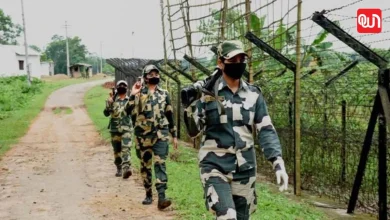Delhi Chokes Under Toxic Smog as AQI Hits ‘Severe’ Level at 408 Near India Gate
Delhi’s AQI touches severe 408 near India Gate, blanketing the city in toxic smog as authorities enforce stricter anti-pollution measures.
Delhi’s Air Quality Worsens: AQI Reaches ‘Severe’ 408 Near India Gate as Toxic Smog Engulfs the City
Toxic Smog Blankets the Heart of Delhi
A thick blanket of toxic smog engulfed central Delhi on Wednesday morning, pushing the Air Quality Index (AQI) to an alarming 408 near India Gate and Kartavya Path. The Central Pollution Control Board (CPCB) confirmed that the AQI level had entered the ‘severe’ category, making breathing conditions extremely hazardous. The city’s skyline remained obscured, and visibility dropped as Delhi continued to struggle with its persistent air quality crisis.
Delhi Records Worst Air of the Season
The situation has worsened steadily over the past few days. On Tuesday, Delhi’s AQI plunged to 423—the worst air quality of the season. In response, the Centre implemented Stage III of the Graded Response Action Plan (GRAP), enforcing tougher restrictions to curb emissions. Areas such as Anand Vihar, Alipur, and Bawana reported extremely high AQI levels at 412, 442, and 462 respectively, indicating widespread pollution. Even popular regions like Chandni Chowk and RK Puram saw AQI readings above 400, confirming severe air toxicity across the capital.
Read more: Bharti Singh’s Rs 20 Lakh Luxury Watch Surprise From Harsh Limbachiyaa Wins Hearts Online
The Scale of Delhi’s Pollution Problem
According to CPCB’s data, Delhi’s AQI has fluctuated between ‘very poor’ and ‘severe’ categories since Diwali. The average AQI recorded on Monday stood at 362, already bordering on severe levels. As per the CPCB norms, an AQI value between 0–50 is ‘Good’, 51–100 ‘Satisfactory’, 101–200 ‘Moderate’, 201–300 ‘Poor’, 301–400 ‘Very Poor’, and anything above 401 is classified as ‘Severe’. Delhi’s current AQI of 408 firmly places it in the most dangerous bracket, indicating air quality that can trigger respiratory illnesses, even in healthy individuals.
Sources of Pollution: Stubble Burning and Vehicular Emissions
Experts attribute the sharp rise in pollution levels to a deadly combination of stubble burning in neighbouring states, vehicular emissions, and stagnant weather conditions that prevent the dispersion of pollutants. Despite repeated measures and restrictions, the annual post-Diwali smog continues to choke Delhi residents. Meteorologists say weak wind movement has worsened the accumulation of PM2.5 and PM10 particles, both of which are dangerous for human health.
CPCB and Ministry Data Show Declining Air Quality
Between January 1 and November 9, 2025, Delhi’s average AQI has been 175, compared to 189 during the same period last year. Although there is a slight improvement statistically, the current episode of smog has undone much of that progress. The Ministry of Environment, Forest and Climate Change reported that PM2.5 levels stood at 75 µg/m³ and PM10 levels at 170 µg/m³—still far beyond the safe limits. Prolonged exposure to such levels can lead to asthma, lung infections, and cardiovascular problems, according to health experts.
Temperature Drop Adds to Air Stagnation
While pollution levels rise, Delhi’s temperature continues to fall, worsening the smog situation. The city recorded a minimum temperature of 10.2°C on Tuesday—about 4.1 degrees below normal—while Aya Nagar witnessed a chilling 9.9°C earlier this week. The dip in temperature has triggered Delhi’s first cold wave of the season, creating a stable layer of cold air that traps pollutants near the surface.
Government Response and Emergency Measures
To control the rising AQI levels, the government has enforced Stage III of the GRAP protocol. This includes halting construction work, restricting diesel generator use, and urging citizens to reduce private vehicle use. Schools have been advised to limit outdoor activities for children, and authorities are monitoring pollution hotspots through real-time CPCB data.
The Health Impact and Way Forward
Doctors warn that Delhi’s air quality has reached a critical level, posing health risks for all age groups. Prolonged exposure to severe AQI levels can aggravate breathing difficulties, allergies, and heart-related ailments. Experts suggest adopting long-term measures like promoting electric mobility, enhancing public transport, and implementing stricter controls on industrial emissions. Citizens are also urged to wear masks, use air purifiers, and stay indoors during peak pollution hours.
Read more: Kim Kardashian Channels Halle Berry–Inspired Bond Look at Kris Jenner’s Glamorous 70th Birthday Bash
Conclusion
As Delhi continues to battle toxic smog, the AQI readings around India Gate and beyond reveal a dire environmental emergency. While the government’s immediate response under GRAP Stage III is necessary, long-term commitment and collective public effort are crucial to reversing the capital’s air pollution crisis. Until then, Delhi’s residents must brace for another winter under a blanket of hazardous smog.
We’re now on WhatsApp. Click to join.
Like this post?
Register at One World News to never miss out on videos, celeb interviews, and best reads.








